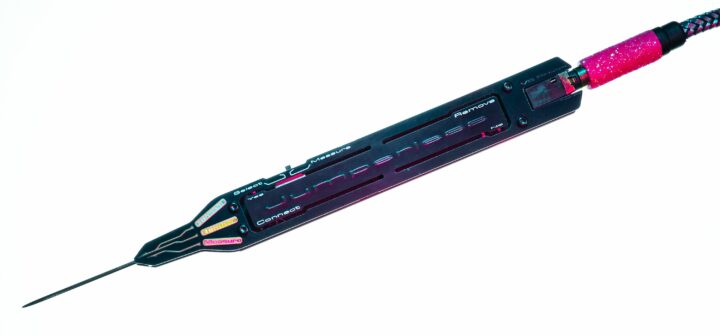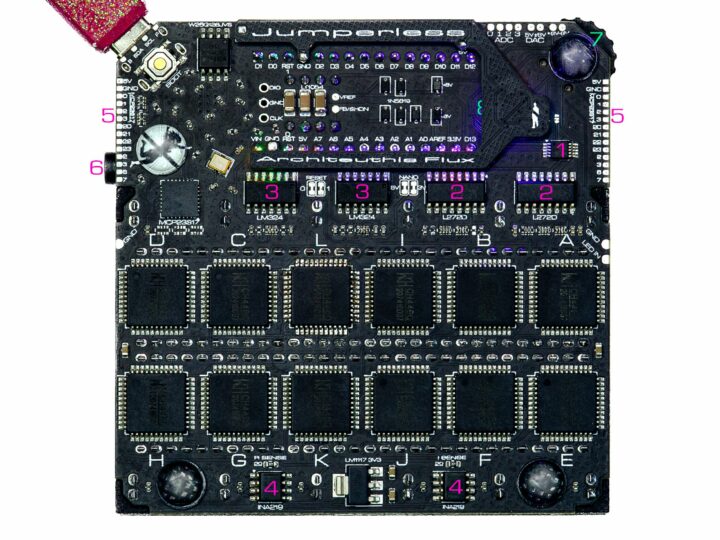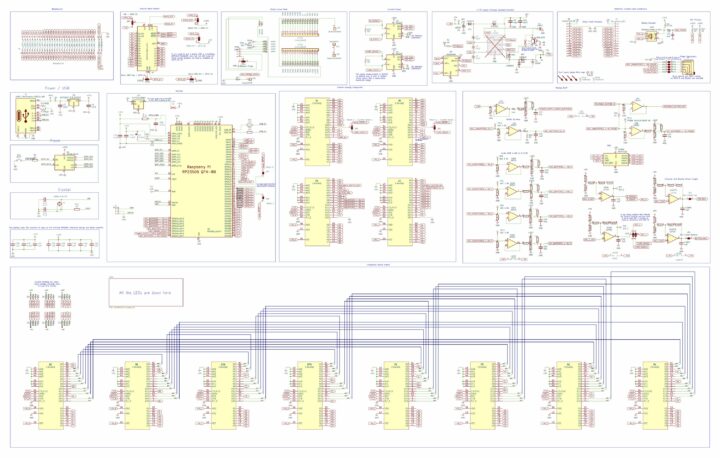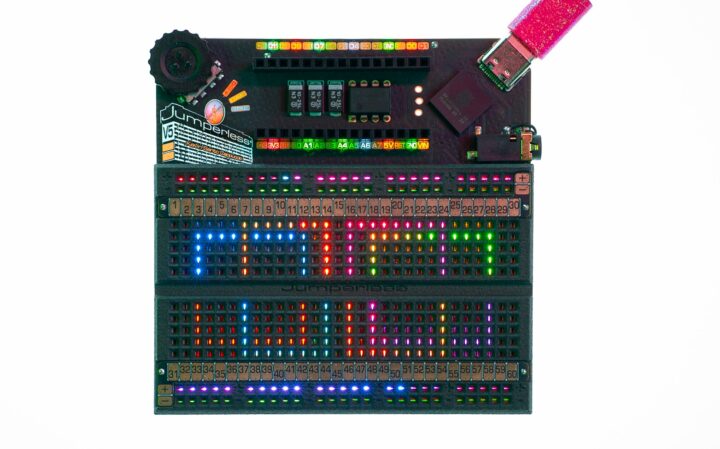Jumperless V5 is a one-of-a-kind, programmable breadboard based on a Raspberry Pi RP2350B microcontroller that lets you skip the jumper wires and jump right into prototyping. It is described as “an Integrated Development Environment (IDE) for hardware.” The Jumperless V5 also removes the need for test equipment as it comes with built-in power supplies and can function as a multimeter, oscilloscope, function generator, and logic analyzer.
As the name implies, the Jumperless V5 breadboard is a revamped version of the original Jumperless, with significant upgrades to make the board easier to use. The Jumperless V5 features a 14 x 30 LED matrix display under the breadboard, a probe for making connections and measurements, four ±8 V, 300 mA power supplies, daisy-chain headers, and overcurrent/overvoltage protection.

The software-defined jumpers allow all points to be connected. The four individually programmable ±8 V power supplies, GPIOs, and management channels for voltage, current, and resistance can be connected anywhere on the breadboard or the Arduino Nano header.

The Jumperless V5 programmable breadboard supports “optional computerless operation.” Full control is offered over the serial terminal interface, and via the onboard click-wheel, probe, and LEDs. One Raspberry Pi 2350B core handles the essential operations while the other core runs a Python interpreter with a built-in module for making function calls and executing scripts without an external computer.
Jumperless V5 specifications:
- MCU – Raspberry Pi 2350B, dual-core ARM Cortex-M33 or Hazard3 RISC-V @ 150MHz
- Memory – 520 KB RAM
- Storage – 16 MB built-in flash storage
- Display – 451 RGB LEDs (5 per row)
- USB – USB Type-C
- Peripherals
- 4x 12-bit DACs (Microchip MCP4278)
- 7x 12-bit ADCs (built into the RP2350)
- 2x 12-bit current/voltage sensors (Texas Instruments INA219)
- 4x 5V logic-level GPIO (MCP23S17)
- 6x 3.3V logic-level GPIO (RP2040)
- 2x 14-pin daisy-chain headers to pass 8 analog signals, SPI, and power to another board
- Arduino Nano header
- Switching Method – Analog crossbar matrix of 12 CH446Q switches
- Circuit Input – Always-on Probe, Wokwi, Thumbwheel, Terminal, Routable UART, Text file, Python
- Measurement – Voltage, current, resistance, frequency, digital data
- Power Output
- Power Rails – Individually adjustable ±8V 300mA
- Voltage – -9V to +9V (with overvoltage protection)
- Misc – Rotary encoder/switch, probe (TRRS)
- Dimensions – TBD
Projects can be uploaded to the Jumperless V5 board via USB. They are stored as text files on the board’s 16MB of flash storage and saved in an app library to be run anytime. The Jumperless V5 also accepts commands from UART via the Arduino Nano header. The desktop app can perform firmware updates and poll Wokwi projects for changes.

The Jumperless V5 project is open-source software and hardware, with schematics, design files, firmware, breadboard shell 3D models, and app code for a desktop client publicly hosted in the GitHub repository. The Jumperless V5 is one of the first devices to use the new RP2350B MCU and it joins the likes of the Pimoroni Explorer board, Bus Pirate 5XL and 6 debugging tools, and the Cytron IRIV IO Controller.
The Jumperless V5 campaign has surpassed its funding goal on Crowd Supply. It is priced at $349 with free worldwide shipping. The maker states that returns will always be accepted, full refunds will always be offered and repairs will always be free.

Tomisin is a writer specializing in hardware product reviews, comparisons, and explainers. He is very passionate about small form factor and single-board computers.
Support CNX Software! Donate via cryptocurrencies, become a Patron on Patreon, or purchase goods on Amazon or Aliexpress







Wow! This thing is so good i am tempted to order even though i no longer need such a thing. Those days were in a previous life it seems now
In fact I never knew jumper-less breadboards are even a thing. How does this even connect any point to almost any other point ? It’s like a Software Defined Breadboard
It uses a matrix of analogue switches to let it connect any point to other points.
I don’t trust crowdfunding and it is not my fault.
I don’t either and it’s not your fault. Crowd Supply is very different from Kickstarter though. They don’t start a campaign until you have working prototypes in hand, and the projects that they accept are picked by the staff, so there’s a vibe check involved. I don’t think a product on there has ever funded and not shipped.
But either way, they’ll remain available in stock at Mouser and their website after the campaign ends.
How does this manage to cope with the gpio input issues of the rp2350?
I think a lot of the issues with that are a bit overblown, because the situation where it becomes relevant isn’t too common, and there are quite a few workarounds if you’re aware of it.
On the Jumperless V5, the one place where it came up was the insane probe setup where I’m reading 2 buttons and sending WS2811 LED data over a single wire. You toggle the pullups and pulldowns to know whether it’s being pulled to ground or just floating.
In practice, all that means is you need to wrap your GPIO read functions in an enable/disable call:
gpio_set_input_enabled(9, true);
buttonState = gpio_get(9);
gpio_set_input_enabled(9, false);
There are different situations where this isn’t the best workaround (mainly PIO) but for most cases this works fine.
The big thing is backwards compatibility for code written for the RP2040 that you can’t edit for whatever reason.
I was interested until I saw the price. That’s off by an order of magnitude surely? How on earth does it cost as much as a full blown x86 PC?
Most likely because it’s not mass produced and not just a copy of another product.